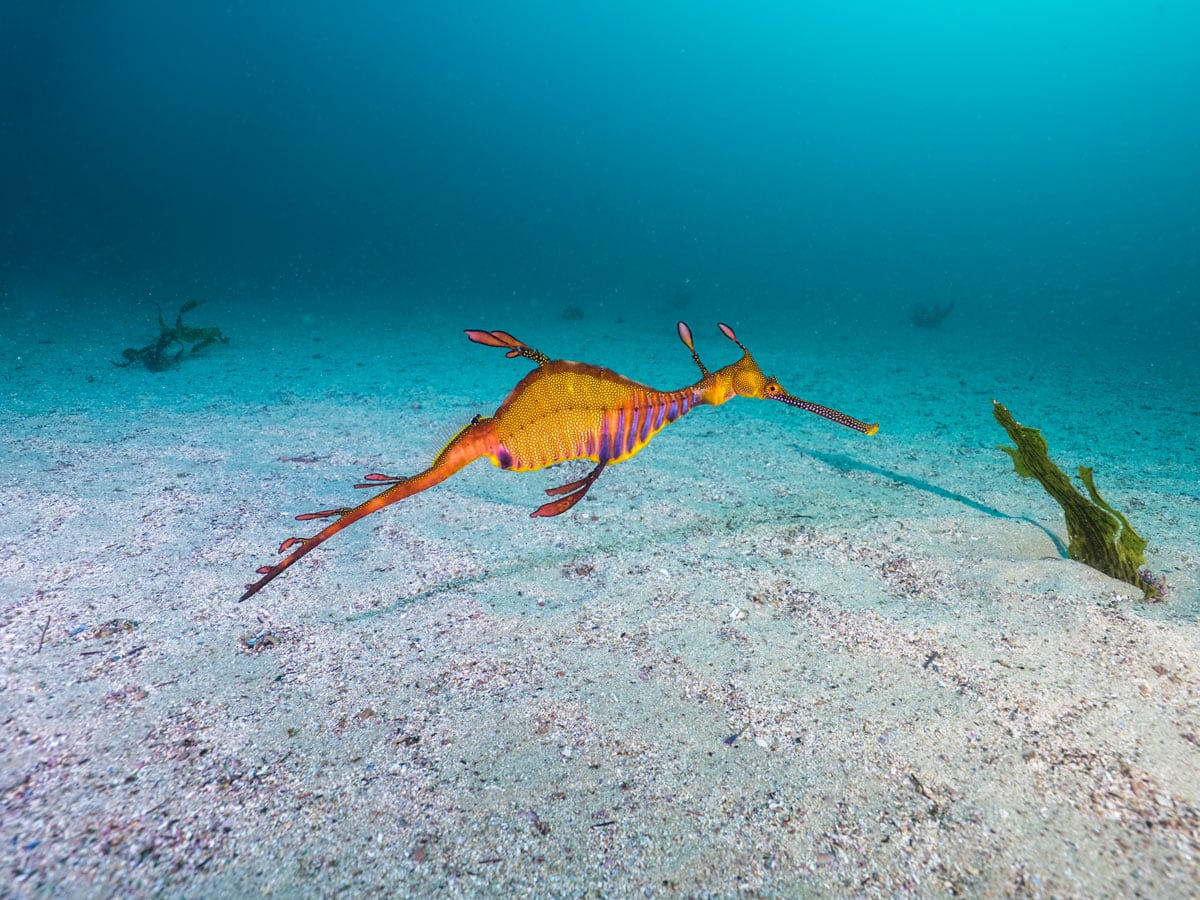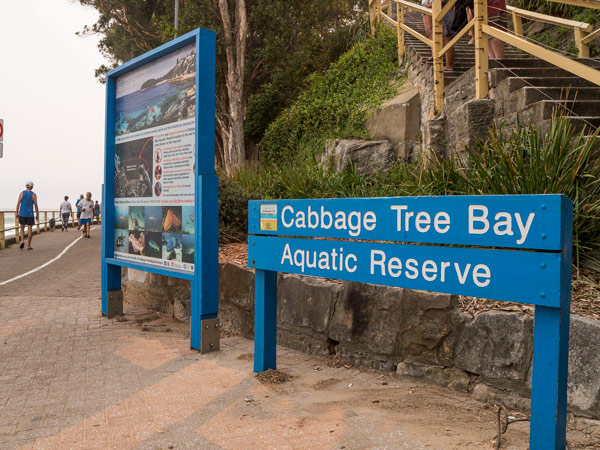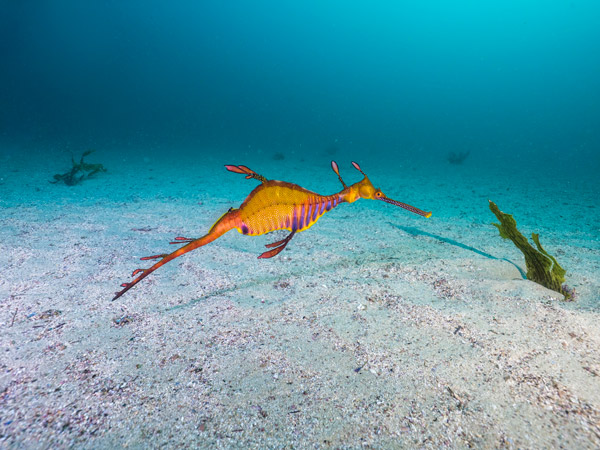27 November 2023
![]() 11 mins Read
11 mins Read

Forget the Great Barrier Reef, Sydney’s coastline is peppered with world-class waters that demand a mask and fins. From enormous schools of fish and spectacular sponge gardens to sea turtles and the odd wobbegong, snorkelling in Sydney rivals anything you’d find on an overseas holiday.
What it offers: At least 160 fish species spanning tropical, protected (like sea dragons) and temperate varieties.
Getting there: Walk over from the southern end of Manly Beach along its scenic walkway. If you’re driving, secure a spot at the ticketed Shelly Beach car park.

Cabbage Tree Bay Aquatic Reserve is located off the northern coast of Sydney. (Image: Destination NSW)
Being a fully protected aquatic reserve has its benefits and Cabbage Tree Bay Aquatic Reserve near Shelly Beach has reaped the rewards after a decade of sanctuary.

Appreciate the beauty underneath Cabbage Tree Bay Aquatic Reserve. (Image: Destination NSW)
Sheltered from the ocean swell on most days, this epic spot to go snorkelling in Sydney provides serious diversity with everything from large schools of mullet and trevally to small harmless sharks such as dusky whalers and wobbegongs. You might even see a hawksbill turtle if you’re lucky.

Lush underwater sanctuaries at Cabbage Tree Bay Aquatic Reserve will take your breath away. (Image: Destination NSW)
On Shelly Beach itself you’ll find bathrooms, showers and electric barbecues plus The Boathouse Shelly Beach, which dishes up a delicious breakfast and lunch and a range of killer cocktails. If you fancy sitting back and letting an expert take the lead out there, try Eco Treasures who offer a two-hour guided snorkelling tour that includes a nature walk and all your gear.

Stumble upon a crested horn shark. (Image: Destination NSW)
What it offers: Sensational snorkelling for beginners due to its protected waters, plus plenty of gropers and young fish varieties, rock lobsters and prawns.
Getting there: There’s free on-street parking around the beach in addition to a carpark on the southern side that’s about 100 metres from the water.

Clovelly Beach is one of Sydney’s best kept secrets.
The underwater topography is quite dramatic under the lip of the Clovelly Ocean Pool’s edge, located on the southern side of this hot spot. Big boulders harbour giant cuttlefish and sponges.

Walk along the edge of the rocky ridges at Clovelly Beach. (Image: Andy Wang)
If you’re up for a bit of a journey (strong swimmers only and only attempt when glassily flat), you can explore more of the Bronte-Coogee Aquatic Reserve by snorkelling around the point to Gordons Bay. Along the way, you might come face to face with the region’s famous 1.2-metre blue grouper Bluey.

Take a break away from the city noise at Gordons Bay. (Image: Destination NSW)
Clovelly is a reassuring place for novices and there’s great facilities nearby including Sea Salt, a cafe steaming up great coffee, food and booze, picnic tables, a toilet block and showers.

Bask in tranquility at Clovelly Beach. (Image: Andy Wang)
What it offers: Beginner level snorkelling due to its shallow slope from the beach towards the water making it super easy to enter. There’s also sea slugs and a variety of fish species.
Getting there: There’s limited street parking on Woods Parade. Otherwise, walking from Manly Wharf along Fairlight Walk takes just under 15 minutes.

Plunge into the Fairlight Rock Pool next to the beach.
Being so close to the shore, the long, protected reef on the North Harbour side of Manly makes Fairlight a great introduction to snorkelling for kids. You can swim out a fair distance and still be in three or four feet of water before the shelf ultimately drops off. Look out for kelp fish and John Dory. Snorkelling is at its best in the morning and afternoon with a favourable northerly wind.
There are showers and toilets on the beach, plus there’s an ocean pool to relax in once you’re done bobbing for sea life.

Balgowlah Heights offers panoramic views of Fairlight Beach.
What it offers: An inland lagoon filled with calm conditions and an array of fish and sea life.
Getting there: You can bushwalk in from West Head Carpark and camp at the Basin or get the ferry across from Palm Beach.
Avoid the crowds and head to The Basin Campground on the eastern shores of Ku-ring-gai Chase National Park on Pittwater. Upstream, the estuary is protected by a shark net so you can watch the tides go in and out along the seagrass beds with little worry. There are plenty of smaller tropical species in the warmer months but also keep your eyes peeled for seahorses, small cuttlefish and schools of rays.
The campground sells ice and firewood if you choose to stay overnight at this Sydney snorkelling winner and there’s also toilets, cold showers, picnic tables and barbecues to take advantage of while you’re visiting.

Admire underwater sceneries at the inland lagoon of The Basin Campground. (Image: Andrew Gregory; Destination NSW)
What it offers: Shallow depths and awesome visibility that attract eager divers, plus rarer fish species including pineapple fish and red Indian fish, and octopus.
Getting there: It’s located at the south end of Anzac Parade and there’s street parking but be prepared to lug your gear down to the water because it’s not exactly close.

Traverse the stilted walkway to Blak Markets on Bare Island, La Perouse. (Image: Destination NSW)
You might recognise Bare Island from Mission: Impossible 2 (that motorbike zooming onto the island scene) but snorkelling here is a much more calming experience.
In its tranquil conditions, nooks around the island’s less-exposed coves are ideal for both beginners and the more experienced. On any one day you might come across sea slugs, sponge gardens and pineapple fish or perhaps an octopus or two. Keep an eye out for one of the resident turtles, though they’re hard to spot.
What you will always find, however, are shops, a children’s playground and public toilets right near the island.

Spot resident turtles on Bare Island, La Perouse. (Image: Destination NSW)
What it offers: Stingray spotting plus sea dragons, seahorses, octopuses and a variety of fish species.
Getting there: Once you get to the Kamay Botany Bay National Park, which offers plenty of parking, walk north along the beach until you arrive at Captain Cook’s Landing Place near Silver Beach.

See colourful coral reefs beneath the calm waters of Kurnell. (Image: Destination NSW)
At Botany Bay’s southern entrance, Kurnell is perhaps the most underrated snorkelling location in Sydney, harbouring the largest congregation of weedy sea dragons, which looks a lot like a seahorse, in Australia.

Kurnell is home to diverse marine species like weedy sea dragons. (Image: Destination NSW)
Captain Cook’s first stomping ground is one of the most diverse underwater communities on the city’s coast, home to moray eels, Port Jackson sharks and loads more. Occasionally, you may be surprised by an Antarctic fur seal or two, too.

Dive into the depths of Kurnell to spot more sea creatures. (Image: Destination NSW)
Try Silver Beach for an easy entry point. There are a bunch of cafes and restaurants to be found along Captain Cook Drive which is within walking distance from Captain Cook’s Landing Place.

Explore beneath the vast seascape of Kamay Botany Bay National Park, Kurnell. (Image: Destination NSW)
What it offers: Blue gropers, large schools of fish and other fish varieties.
Getting there: A walk north up the hill from Manly, Freshwater Beach is found on Ocean View Road and there’s a carpark plus some street parking.

Witness the ripples gently hitting the rocks on Freshwater Beach. (Image: Aaron Birch)
There’s really nice snorkelling off Freshy but the caveat is that you really have to check sea conditions to make sure waves aren’t breaking heavily on the rocks. Look out for a southerly, too.
When it’s calm, park up in the car park, stroll down to the beach and walk around the swimming pool and enter at the inflow (keep the rocks to your left). There are loads of schooling fish such as king fish to keep you focused.
There are public toilets at the beach plus an eight-lane saltwater ocean pool at the north end. You’ll also find a feed at one of the cafes that overlook the beach.

Laze around the cream-coloured sand of Freshwater Beach. (Image: Adam Krowitz)
What it offers: Decorator crabs and sponges plus loads of fish species, seahorses, barnacles and oysters.
Getting there: Travel by car and park along Chowder Bay Road to avoid having to pay for metered parking at the public car park at Clifton Gardens.
A colourful world of underwater life can be found shacked up along the jetty, sea floor and pylons at Chowder Bay, accessible via Clifton Gardens Reserve. Navigate its slow-paced waters to spot decorator crabs, Eastern Fiddler Rays, large schools of fish, two species of seahorses and the zebra-striped Old Wife Fish.
There’s also a bunch of shellfish to sniff out. Once you’re done, take a carefree dip in the netted area, one of Sydney’s best secret swimming spots. You’ll also find a children’s playground, toilet block and barbecues in the area.
What it offers: Two shipwrecks, octopuses, a smorgasbord of fish species and the occasional ray.
Getting there: There’s some street parking along Dacre Street and Bay Parade but if you can’t find a spot, try the parking bay on Fisherman’s Drive.

Follow beach route from Malabar Headland National Park Coastal Walk.
Protected by cliffs at either ends, Malabar Beach offers family-friendly snorkelling in Sydney. It also draws the diving crowd thanks to its two individual shipwrecks which crashed in 1931 and 1955. While diving does offer the ultimate vantage point, snorkelling can provide glimpses of the historical sites.
But if it’s action you seek, you’ll be far more impressed by the vivid sea life dotted with fish and larger scene-stealers. Change rooms, public toilets, showers and a fenced playground are all located nearby.

Fiery hues paint the sky over Malabar Beach.
What it offers: Gropers, cuttlefish, octopuses and a variety of rays — if you’re lucky.
Getting there: There’s on-street parking along Ewos Parade. Once you’ve found a spot, head down the Esplanade Walkway on the Cronulla Peninsula.
As pretty as Oak Park is, flipper straight towards the crescent-shaped wall to find some of the best snorkelling in Sydney.
You’ll lose yourself in the fascinating sponge gardens as well as a plethora of vividly hued fish species. Stay alert for rays too, though they’re quite challenging to find (making it all the more fun), and don’t be surprised to catch a groper shuffling at your tail.
The park itself features public toilets, barbecues, a small playground, showers and change rooms.
What it offers: A picture-perfect waterfall as an idyllic backdrop plus schools of fish, Port Jackson sharks and a rainbow of sponges.
Getting there: Once you’re in the Royal National Park, follow the signs to the Wattamolla Beach parking areas. It’s about a 400-metre walk to the water from there.

Go frolicking on Wattamolla Beach. (Image: Dee Kramer Photography)
Snorkelling in Sydney doesn’t get much prettier than this. Wattamolla Beach at the southern tip of the city offers still, clear waters in a sheltered lagoon for novices to explore.
Got plenty of experience under your belt? Venture further into the ocean as you hunt for harmless wobbegong and Port Jackson sharks, rays and a myriad of brightly coloured sponges and sea squirts. Make a day of it by bringing lunch and enjoying it in the nearby picnic area where you’ll find barbecues and toilets.

Have a picnic with your family at Wattamolla Beach. (Image: Destination NSW)
awesome information
Thankyou for this, some great future smorkel projects.
Thankyou.